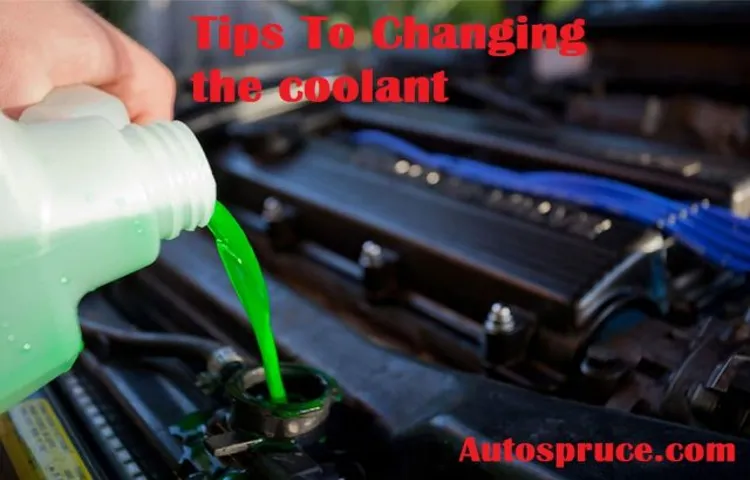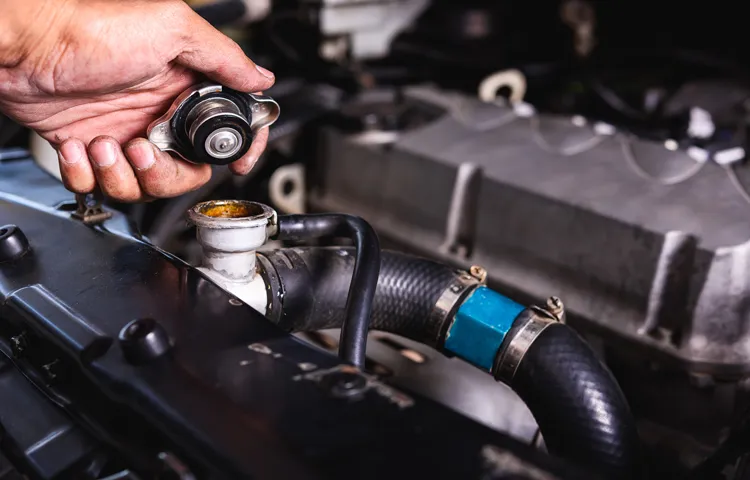Is your car running hot? Are you noticing steam coming from under the hood? These could be signs that your vehicle is in need of coolant. Coolant, also known as antifreeze, plays a crucial role in maintaining the optimal temperature of your engine. Without it, your car can overheat, causing extensive damage that could be costly to repair.
But how can you tell if you need coolant? In this blog post, we will explore some common indicators that your car may be in need of coolant and discuss the importance of addressing this issue promptly. So, let’s dive in and discover how to keep your engine running cool and smooth!
Table of Contents
Understanding Coolant
How do you know if you need coolant for your vehicle? Well, the first thing to look out for is if the temperature gauge on your dashboard is showing a higher reading than usual. If it’s higher than the normal range, it could be a sign that your engine is overheating and in need of coolant. Another indicator is if you notice steam coming from under the hood of your car.
This can be a clear sign that your engine is overheating and coolant is needed to bring down the temperature. Additionally, if you see any puddles of coolant or colored liquid under your vehicle, it could mean that there is a coolant leak and you should have it checked out as soon as possible. Remember, keeping an eye on your vehicle’s coolant levels and regularly checking for any signs of overheating or leaks is crucial to maintaining the health and performance of your engine.
What is coolant and what does it do?
coolant, understanding coolant When it comes to taking care of your vehicle, one of the essential fluids you need to pay attention to is coolant. But what exactly is coolant, and what does it do? Well, think of coolant as your car’s best friend in preventing it from overheating. It’s a mixture of ethylene or propylene glycol and water that circulates through your engine and helps maintain a safe operating temperature.
Coolant is vital because it absorbs the excess heat generated by the engine and transfers it to the radiator, where it can be released into the air. This process allows your engine to stay at an optimal temperature, preventing damage from heat buildup. Without coolant, your engine could overheat, leading to expensive repairs or even engine failure.
But coolant does more than just prevent overheating. It also helps to inhibit rust and corrosion within your engine, keeping everything running smoothly. Over time, contaminants and particles can accumulate in your coolant, making it less effective.
That’s why it’s crucial to regularly check your coolant levels and consider flushing and refilling it as recommended by your vehicle manufacturer. Understanding coolant and its role in your vehicle’s cooling system is vital for maintaining the longevity and performance of your engine. So the next time you pop the hood, don’t overlook the importance of that colorful fluid – it’s there to keep your engine running smoothly and prevent overheating.

Importance of coolant in your car’s engine
coolant, engine, importance, car
Signs Your Car Needs Coolant
Have you ever found yourself wondering if your car needs coolant? It’s an important question to ask, as having the right amount of coolant is crucial for keeping your engine running smoothly. Fortunately, there are a few signs that can indicate when your car is in need of coolant. One of the most noticeable signs is when your car’s temperature gauge starts to rise higher than normal.
If you notice that your car is running hotter than usual, it could be a sign that your coolant levels are low. Another sign to look out for is a sweet, sugary smell coming from your engine. This could indicate a coolant leak.
Additionally, if you notice any white smoke or steam coming from your engine, it’s a clear sign that your car is overheating and needs coolant. Overall, it’s important to be aware of these signs and to regularly check your coolant levels to ensure your car is running at its best.
Visible coolant leak
coolant leak, car needs coolant
Overheating engine
overheating engine, signs your car needs coolant
Low coolant warning light
car coolant, low coolant warning, signs of low coolant, car maintenance, engine overheating. Picture yourself cruising along the highway, enjoying your favorite tunes, when suddenly, a warning light catches your eye – the low coolant warning light. Your heart skips a beat as you wonder what it could mean.
Is your engine about to overheat? Are you in danger of being stranded on the side of the road? Before you panic, let’s take a closer look at what this warning light is trying to tell you and the signs that your car needs coolant. One of the most obvious signs that your car needs coolant is if the low coolant warning light illuminates on your dashboard. This light is designed to alert you when the coolant level in your car’s engine is too low.
So, what exactly does coolant do and why is it important? Well, coolant, or antifreeze, is responsible for regulating the temperature of your car’s engine. It circulates through the engine, absorbing excess heat and preventing it from overheating. If the coolant level in your car is too low, it can lead to serious problems.
Your engine may overheat, which can cause major damage and even result in a breakdown. So, it’s important to keep an eye out for other signs that your car needs coolant, such as a rising temperature gauge. If you notice that your temperature gauge starts to creep into the red zone or your car’s engine starts to overheat, it’s a clear indication that your coolant level is too low.
Another sign to watch out for is a sweet, syrupy smell coming from your car’s vents. This smell is a tell-tale sign that your coolant is leaking. Coolant leaks can happen for a variety of reasons, such as a cracked radiator or a faulty hose.
Regardless of the cause, it’s important to address the issue promptly to prevent further damage to your engine. In addition to these signs, you may also notice a puddle of coolant under your car when it’s parked. This is a clear indication that you have a coolant leak.
Checking Coolant Levels
Have you ever wondered how to tell if you need coolant for your car? Well, one surefire way is to check the coolant levels in your vehicle. Coolant, also known as antifreeze, plays a crucial role in keeping your engine running smoothly and preventing overheating. Low coolant levels can lead to serious damage to your engine, so it’s important to keep an eye on it.
So, how do you check your coolant levels? It’s actually quite simple. First, make sure your car is parked on a level surface and the engine is cool. Then, locate the coolant reservoir, which is usually a translucent plastic tank near the radiator.
The reservoir will have min and max markings on it, indicating the desired coolant levels. Simply remove the cap and take a look inside. If the coolant is below the min marking, it’s time to add more.
On the other hand, if the coolant is between the min and max markings, you’re good to go. Remember, it’s always better to be safe than sorry when it comes to your car’s coolant levels. So, make it a habit to check them regularly and top up as needed.
Your engine will thank you!
How to check coolant levels in your car
Checking Coolant Levels
Using the coolant reservoir
coolant reservoir, checking coolant levels
Reading the coolant level indicator
Checking coolant levels is an essential part of maintaining your vehicle’s engine health. One way to do this is by reading the coolant level indicator. This indicator is typically located on the side of the coolant reservoir and has two marks: “Min” and “Max.
” When the coolant level is between these two marks, it is considered optimal. However, if the coolant level is below the “Min” mark, it indicates that your vehicle may be low on coolant and it needs to be topped up. On the other hand, if the coolant level is consistently above the “Max” mark, it could mean that your vehicle is overfilled with coolant, which can cause overheating issues.
By regularly checking the coolant level indicator, you can ensure that your vehicle’s engine stays cool and avoid potential problems down the road. So, the next time you pop the hood of your car, don’t forget to take a quick glance at the coolant level indicator to keep your engine in tip-top shape.
Adding Coolant
If you find yourself wondering how to know if you need coolant for your vehicle, there are a few signs to look out for. The first indicator is a warning light on your dashboard. If the coolant level is low, this light will typically come on to alert you.
Another sign is an overheating engine. If your engine is running hotter than normal or if you notice steam coming from under the hood, it’s a good idea to check your coolant level. You can also physically check the level by lifting the hood and locating the coolant reservoir.
This reservoir is typically a translucent plastic container with markings indicating the minimum and maximum levels. If the coolant falls below the minimum line, it’s time to add more. Adding coolant is a simple process, but it’s important to use the correct type and mix it with water as specified by your vehicle’s manufacturer.
Regularly monitoring your coolant level and being proactive about adding coolant when needed can help prevent engine damage and keep your vehicle running smoothly.
Steps to add coolant to your car
coolant, add coolant, car cooling system, engine temperature, overheating, coolant reservoir, radiator, coolant level, maintaining a proper coolant level, coolant mixture, coolant color, engine coolant capacity, coolant top-up, coolant replacement, coolant maintenance, car maintenance, do-it-yourself car maintenance. Paragraph: Hey there, car enthusiasts! Today, let’s talk about a crucial aspect of maintaining your car’s cooling system – adding coolant. Your car’s engine generates a lot of heat as it runs, and it’s the cooling system’s job to keep things running smoothly.
If the engine temperature rises too high, it can lead to overheating and potential engine damage. To prevent this, it’s important to regularly check the coolant level in your car’s cooling system and ensure it’s at the proper level. The first step is to locate the coolant reservoir, which is usually translucent and has “coolant” marked on it.
Once you find it, make sure the engine is cool before removing the cap to avoid any potential burns. Check the coolant level by looking at the markings on the side of the reservoir. If it’s below the recommended level, it’s time to add coolant.
But remember, not all coolants are the same, so it’s essential to choose the right type for your car. Additionally, keep an eye on the color of your coolant. Over time, coolants can become contaminated and lose their effectiveness, so it’s crucial to replace them if they become discolored or dirty.
If you’re unsure about your car’s coolant capacity or the right coolant mixture, consult your owner’s manual or reach out to a professional for guidance. When adding coolant, make sure to follow the manufacturer’s instructions and mix the coolant with the appropriate amount of water if necessary. Always remember to replace the cap securely once you’ve topped up the coolant to the proper level.
By taking these steps, you’ll be on top of your car’s coolant maintenance and ensuring your engine stays cool as a cucumber.
Choosing the right coolant type
Choosing the right coolant type is crucial when it comes to keeping your vehicle’s engine cool and running smoothly. One important aspect of maintaining the proper coolant level is knowing how to add coolant to your vehicle. Adding coolant is a simple process that can be done by any car owner, but it’s essential to follow a few steps to ensure it’s done correctly.
First, locate the coolant reservoir under the hood, which is typically a clear plastic tank with a cap that says “coolant” or “radiator.” Open the cap carefully when the engine is cool, as hot coolant can be dangerous. Check the coolant level and add a 50/50 mixture of coolant and water if needed.
It is important to use the proper coolant type recommended by your vehicle manufacturer to avoid any damage to your engine. If you’re unsure which coolant type to use, consult your owner’s manual or ask a professional mechanic for guidance. By following these steps, you can ensure that your engine stays cool and protected from overheating.
Precautions while adding coolant
“Adding coolant to your vehicle is an important part of maintenance that helps regulate the engine temperature and prevent overheating. However, it’s important to take some precautions while adding coolant to ensure the process goes smoothly. First and foremost, always make sure that the engine is completely cool before adding coolant.
Trying to add coolant to a hot engine can lead to burns and other injuries. Additionally, it’s important to use the correct type of coolant for your vehicle. Different vehicles require different types of coolant, so check your owner’s manual or consult with a professional to determine the appropriate coolant for your car.
When adding coolant, it’s important to do so slowly to avoid any spills or messes. Take your time and pour the coolant into the reservoir or radiator carefully. Finally, be sure to check the coolant levels regularly to ensure the proper functioning of your vehicle’s cooling system.
By following these precautions, you can safely and effectively add coolant to your vehicle.”
Conclusion
Well, my dear friends, it’s time to take a trip down the slippery slope of automotive knowledge. How do you know if you need coolant? It’s a question that has plagued mankind since the invention of the automobile. But fear not, for I am here to shed some light on this perplexing puzzle.
Imagine, if you will, you’re cruising down the open road, wind in your hair and a smile on your face. Suddenly, your trusty steed starts to sputter and groan. Panic sets in, and you pull over to the side of the road.
But what could be the cause of this catastrophe? Ah, dear comrades, it may just be that your engine is overheating. Now, you may be wondering, how can one determine if their engine is indeed overheating? The answer lies in the magical elixir known as coolant. This marvelous liquid substance flows through your engine, keeping it cool and collected.
Without it, your engine would resemble a volcano ready to erupt. But fear not, my fellow adventurers, for there are signs that indicate when your engine is desperately in need of coolant. First and foremost, a rising temperature gauge on your dashboard is a telltale sign.
If that needle starts creeping towards the red zone, it’s time to pull over and check your coolant levels. Another clue lies in the steam rising from your engine like a smokescreen in a spy movie. If you see this ethereal mist wafting from your hood, it’s a clear indication that your engine is hotter than the sun and in dire need of coolant.
And finally, my friends, the pièce de résistance of coolant detection: the dreaded puddle of mystery beneath your vehicle. If you spot a vibrant and colorful puddle forming under your car, it’s a red flag that coolant may be seeping from your engine like a leaky faucet. So there you have it, intrepid explorers of the automotive world.
FAQs
How do you know if you need coolant?
You might need coolant if your engine is overheating, if you notice a sweet smell in your car, if you see coolant leaking under your vehicle, or if the coolant level is low in your radiator or reservoir.
What happens if you don’t have enough coolant in your car?
If you don’t have enough coolant in your car, your engine can overheat, leading to potential damage or even engine failure. It is important to regularly check and maintain the coolant level in your vehicle.
How often should I check the coolant level in my car?
It is recommended to check the coolant level in your car at least once a month or before any long trips. It is important to maintain the proper coolant level to ensure your engine stays cool and prevent any potential damage.
Can I use water instead of coolant in my car?
While water can temporarily be used as a coolant substitute in an emergency situation, it is not recommended for regular use. Coolant contains additives that help protect your engine from rust, corrosion, and overheating. Using water instead of coolant can lead to engine damage over time.
Can I mix different types of coolant in my car?
It is generally not recommended to mix different types of coolant, as they may have different additives or compositions. Mixing coolants can lead to compatibility issues and potential damage to your cooling system. It is best to use the recommended coolant specified by your vehicle’s manufacturer.
How often should I flush and replace the coolant in my car?
The recommended interval for flushing and replacing the coolant in your car can vary depending on the make and model. Generally, it is recommended to flush and replace the coolant every 2 to 5 years or according to your vehicle’s owner’s manual. This ensures that the coolant remains effective in protecting your engine.
Can I top up the coolant in my car with any brand?
It is generally safe to top up the coolant in your car with any brand that is compatible with your vehicle’s specifications. However, it is always best to use the same brand and type of coolant to ensure compatibility and optimal performance. Consult your owner’s manual or a professional mechanic for guidance if unsure.



